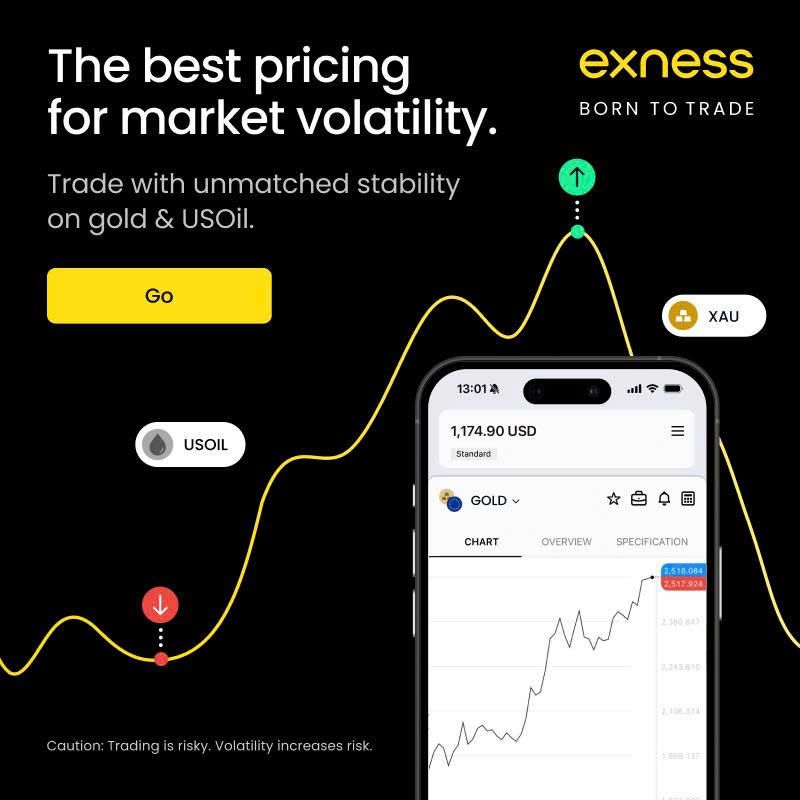
7 minute read
How to Trade Forex with $50: A Beginner’s Guide to Getting Started
from How Trade Forex $50
Trading forex with just $50 might sound like a long shot, but it’s absolutely possible to start small and still make progress in the forex market. With the right mindset, strategy, and tools, you can turn that modest capital into a learning experience—and potentially grow it over time. In this guide, I’ll walk you through practical steps to trade forex with $50, keeping things simple, realistic, and beginner-friendly. Let’s dive in!
Top 4 Best Forex Brokers
1️⃣ Exness: Open An Account or Visit Brokers 🏆
2️⃣ XM: Open An Account or Visit Brokers 💥
3️⃣ JustMarkets: Open An Account or Visit Brokers ✅
4️⃣ Quotex: Open An Account or Visit Brokers 🌐
Why Start Forex Trading with $50?
Forex trading is one of the most accessible markets because you don’t need a fortune to get started. With $50, you can open a micro account, practice real-world trading, and learn without risking too much. The key is to focus on education, discipline, and small, consistent gains rather than chasing quick profits. Here’s how to make it work.
1. Choose the Right Broker for Low-Capital Trading
Your $50 won’t go far unless you pick a broker that supports micro accounts and low minimum deposits. Look for these features:
Low Minimum Deposit: Many brokers allow you to start with $50 or less. Popular options include XM, FBS, or OctaFX, which cater to small accounts.
Micro or Cent Accounts: These accounts let you trade in smaller lot sizes (e.g., 0.01 lots), so your $50 can handle more trades without being wiped out.
Low Spreads and Fees: High spreads can eat into your capital fast. Choose brokers with tight spreads on major pairs like EUR/USD.
Regulation: Ensure the broker is regulated by a reputable authority (e.g., FCA, ASIC, or CySEC) to protect your funds.
Pro Tip: Check if the broker offers a demo account. Practice there first to get a feel for their platform before risking your $50.
2. Understand Leverage and Risk Management
With only $50, leverage is your friend—but it’s also a double-edged sword. Leverage lets you control larger positions with small capital, but it can amplify losses. Here’s how to use it wisely:
Start with Low Leverage: Brokers may offer 1:500 or higher, but stick to 1:10 or 1:50 to keep risks manageable.
Use Proper Position Sizing: Never risk more than 1-2% of your account per trade. For $50, that’s $0.50-$1 per trade.
Set Stop-Loss Orders: Always use stop-losses to cap potential losses. For example, if you’re trading 0.01 lots, set a stop-loss at 10-20 pips to limit risk.
Example: If you’re trading EUR/USD with a $50 account and 1:10 leverage, a 0.01-lot position requires about $10 margin. A 20-pip stop-loss keeps your risk at $2, which is 4% of your account—still a bit high, so adjust to smaller lots if needed.
3. Pick a Simple Trading Strategy
Complex strategies can overwhelm beginners, so stick to something straightforward. Here are two beginner-friendly strategies for trading with $50:
a. Price Action Trading
Focus on clean charts without overloading indicators. Look for patterns like support and resistance levels, pin bars, or engulfing candles. For example:
Identify a major support level on the EUR/USD 1-hour chart.
Wait for a bullish pin bar to confirm a buy signal.
Enter with a 0.01-lot position and a 15-pip stop-loss.
b. Moving Average Crossover
Use two simple moving averages (e.g., 50-period and 200-period) to spot trends:
Buy when the 50-period MA crosses above the 200-period MA.
Sell when it crosses below.
Keep trades small to stay within your $50 budget.
Pro Tip: Test your strategy on a demo account for at least a month to ensure it suits your style and the market conditions.

✅ Trade with Exness now: Open An Account or Visit Brokers 👈
4. Focus on Major Stuart with Low-Capital Trading
With only $50, every cent counts, so you need to be strategic about the currency pairs you trade. Stick to major pairs like EUR/USD, USD/JPY, or GBP/USD because they have:
Lower Spreads: Typically 0.5-1 pip, which saves you money.
High Liquidity: Easier to enter and exit trades without slippage.
Predictable Movements: Major pairs tend to follow technical patterns better than exotic pairs.
Avoid exotic pairs (e.g., USD/TRY) as they have higher spreads and volatility, which can quickly drain your $50.
Example: On EUR/USD, a 0.01-lot trade with a 1-pip spread costs just $0.10, whereas an exotic pair with a 10-pip spread costs $1—2% of your account!
5. Build a Trading Plan and Stick to It
A solid trading plan keeps you disciplined and protects your $50. Here’s a simple framework:
Goal: Aim for small, consistent gains (e.g., 5-10% per month) rather than doubling your account overnight.
Risk Management: Never risk more than 1-2% per trade. For $50, that’s $0.50-$1.
Trading Hours: Focus on high-liquidity sessions like the London or New York sessions for better price movements.
Journaling: Record every trade—entry, exit, profit/loss, and why you took it. Review weekly to spot mistakes.
Pro Tip: Treat your $50 as a learning investment. The goal isn’t to get rich quick but to build skills for long-term success.
6. Manage Your Emotions
Trading with $50 can feel like a rollercoaster. You might see a $5 loss and panic, or a $5 gain and get overconfident. Here’s how to stay calm:
Accept Losses: Losses are part of trading. Focus on the long-term process, not short-term results.
Avoid Overtrading: Don’t take trades just to “do something.” Wait for high-probability setups.
Take Breaks: Step away after a losing streak to clear your head.
Example: If you lose $3 on a trade, don’t immediately jump into another to “make it back.” Review what went wrong and wait for a better opportunity.
7. Use Free Resources to Learn
You don’t need to spend money on courses to learn forex. There are tons of free resources online:
YouTube Channels: Look for reputable traders like The Trading Channel or Rayner Teo for beginner-friendly content.
Websites: Babypips.com offers a free “School of Pipsology” that covers everything from basics to advanced strategies.
Forums: Join communities like Reddit’s r/Forex to ask questions and learn from others.
Pro Tip: Spend 1-2 hours daily studying. Knowledge is your edge when trading with small capital.
8. Avoid Common Pitfalls
Beginners with $50 often make these mistakes. Here’s how to avoid them:
Overleveraging: High leverage can wipe out your account in one bad trade. Stick to low leverage.
Chasing Losses: Don’t double your position size to recover losses—it’s a recipe for disaster.
Ignoring Fees: Spreads, commissions, and swap fees can eat into your $50. Always factor them in.
Gambling Mentality: Treat forex like a business, not a casino. Focus on strategy, not luck.
9. Scale Up Gradually
Once you’re consistently profitable on a demo account or your $50 live account, consider adding more funds to grow your trading capital. Here’s a roadmap:
Month 1-3: Practice on a demo account and refine your strategy.
Month 4-6: Trade live with $50, aiming for 5-10% monthly returns.
Month 6+: If profitable, add $50-$100 to your account and increase position sizes slightly.
Example: If you grow your $50 to $75 in six months, you’ve gained valuable experience and can confidently add more capital.
Final Thoughts: Start Small, Think Big
Trading forex with $50 is a fantastic way to dip your toes into the market without risking too much. By choosing the right broker, using low leverage, sticking to a simple strategy, and staying disciplined, you can turn your small account into a stepping stone for bigger goals. The key is patience—treat your $50 as a learning tool, not a get-rich-quick scheme.
✅ Trade with Exness now: Open An Account or Visit Brokers 👈
Read more:

